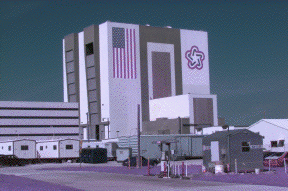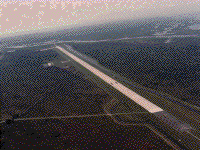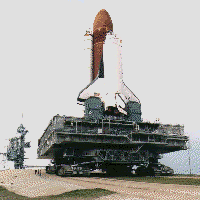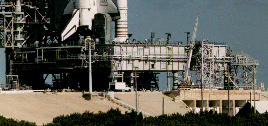|

Launch Complex 39-A & 39-B
Launch Complex 39's Pad A and Pad B were originally
designed to support the Apollo
program and were modified for Space Shuttle launch operations. Major changes
included the
erection of a new Fixed
Service Structure (FSS), addition of a Rotating
Service Structure (RSS), and the replacement of the Saturn flame deflectors with three
new flame deflectors. The upper portion of the Saturn V Launch umbilical tower was removed
from two of the Apollo
Mobile Launchers and installed at the pad to serve as the FSS.
Fuel, oxidizer, high pressure gas,
electrical, and pneumatic lines connect the Shuttle vehicle with ground support equipment
and are routed through the FSS,
RSS
and Mobile Launch Platform.
Space Shuttle access and servicing at the
pad are provided by:
The FSS
is topped by a 24.4 meter (80ft) tall fiberglass lightning mast grounded by 335 meter
(1,100ft) cables that are anchored north and south of the pad. The Mast provides lightning
protection for pad structures and the Space Shuttle.
The RSS
accommodates the loading of payloads vertically at the pad. It is mounted on a
semi-circular track which allows it to rotate through an arc of 120 degrees on a radius of
36.6 meters (120 ft). The RSS
pivots from a hinge on the FSS
until the RSS
spacecraft changeout room fits flush with the Orbiters's cargo bay. This room allows
payloads to be installed or serviced under contamination-free or "clean room"
conditions. Click here for a better view
of the RSS
Blast-protected hypergolic storage and
supply systems are provided at each pad, and the Launch Processing System (LPS) is used to monitor all aspects
of vehicle and payload operations. The LPS system interconnects to the MLP through Hardware Interface
Modules (HIM's) located in Pad Terminal Connection Rooms beneath the pads.
Pads 39-A and 39-B are virtually identical
and roughly octagonal in shape. The distance between pads is 2,657 meters (8,715
ft). The
pad base contains 52,000 cubic meters (68,000 cubic yards) of concrete. The ramp leading
up to the pad is inclined at a 5% grade. The flame trench is 13 meters (42 ft)
deep, 137
meters (450ft) long and 18 meters (58 ft) wide. The orbiter flame deflector is 11.6 meters
(38ft) high, 22 meters (72 ft) long and 17.5 meters (57.6 ft) wide. It weights 590,000 kg
(1.3 million lbs). The SRB deflector is 12.95 meters (42.5 ft) high, 12.8 meters (42
ft)
long and 17.4 meters (57 ft) wide. It weights 499,000 kg (1.1 million lbs). The Sound
Suppression Water System is used to protect the launch structure from the intense sound
pressure of liftoff. Its water tank is 88.9 meters (290ft) high and has a capacity of
1,135,000 liters (300,000 gallons).
There are 6 permanent and 4 extensible
pedestals that are used to support the MLP at the
pad. Dynamic loads at
rebound are 3,175,200 kg (7,000,000 lbs) to 4,762,800 kg (10,500,000lb) at
liftoff. The
pad is lit with 5 clusters of Xenon high-intensity searchlights (total
searchlights: 40)
around the pad perimeter.
The height of the Fixed Service Structure
(FSS)
is 105.7 meters (347ft) to the top of the lightning mast (referenced to the pad
base) and
the Rotating Service Structure (RSS)
is 57.6 meters (189ft) high. The Fixed Service Structure (FSS)
and Rotating Service Structure (RSS)
on Pad 39A underwent a renovation between June and September 1993. Some 13,773 gallons of
paint were used on two coats and 1,866 tons of sand were used in the sandblasting
operation.
The LC-39 Launch complex also contains
large liquid oxygen (LOX) and Liquid Hydrogen (LH2) storage tanks. These are large
ball-shaped vacuum jacketed dewar bottles used to store supercold cryogenic propellants
for the shuttle external tank.
The LOX tank, located at the northwest corner of the pad stores 3,406,500 liters (900,000
gallons) of liquid oxygen at a temperature of minus 183 degress C (-298 F). The LH2 tank
is located at the northeast corner of the pad and stores 3,218,250 liters (850,000
gallons) of liquid hydrogen at a temperature of minus 253 degrees C (-423 degrees F).
The Weather Protection System protects
orbiter tiles from wind blown debris, rain and hail. Wheeled metal doors that ride on
steel beams are attached to the Rotating Service Structure and the Fixed Service
Structure. Doors slide together (to within 3 inches of each other) between the orbiter's
belly and the external
tank, providing protection for the lower portion of the orbiter.
- East Door, attached to the RSS
measures 16 meters (53 ft) long, 8 meters (27 ft) tall and weighs 19 metric tons (42,000
lbs).
- West Door, attached to the FSS
measures 13 meters (43 ft) long, 11.6 meters (38ft) tall and weighs 21 metric tons (46,000
lbs)
The top of the orbiter is shielded by an
inflatable seal extending from the Payload Changeout Room forming a semi-circle covering
90 degrees of arc between the orbiter and its external tank.
The sides of the orbiter, between the vehicle and the external tank,
are protected by a series of 20 metal bi-fold doors that fold out from the Payload
Changeout Room. The doors measure 24.4 meters by 1.2 meters (80ft x 4ft).
There is approximately 1.25 million feet
of tubing and piping at Launch Complex 39, varying in sizes from .25 inches to 114 inches
in diameter. This is enough pipe to reach from Orlando to Miami.
 Vehicle Assembly Building Vehicle Assembly Building
The Vehicle Assembly Building (VAB) is one
of the largest buildings in the world. It was originally built for assembly of
Apollo/Saturn vehicles and was later modified to support Space Shuttle
operations. High
Bays 1 and 3 are used for integration and stacking of the complete Space Shuttle
vehicle.
High Bay 2 is used for external tank (ET) checkout and storage and as a contingency
storage area for orbiters. High Bay 4 is also used for ET checkout and storage, as well as
for payload canister operations and solid rocket boster (SRB)
contingency handling.
The Low Bay area contains Space Shuttle
main engine maintenance and overhaul shops, and servs as a holding area for SRB forward
assemblies and aft skirts.
During Space shuttle build-up operations
inside the VAB, integrated SRB
segments are transfered from nearbay SRB
assembly and checkout facilities, hoisted onto a Mobile Launcher Platform in High
Bays 1 or 3 and mated together to form two complete SRBs. The
ET, after arrival by barge, is inspected and checked out in High Bays 2 or 4 and then
transfered to High Bay's 1 or 3 to be attached to the SRBs
already in place. The orbiter is then towed over from the Orbiter Processing Facility to the
VAB transfer aisle, raised to a vertical position, lowered onto the Mobile Launcher Platform and then
mated to the rest of the stack. When assembly and checkout is complete, the crawler-transporter enters the
High Bay, picks up the platform and assembled shuttle vehicle and carries them to the launch
pad.
The VAB covers 3.25 hectares (8
acres). It
is 160 meters (525 ft) tall, 218 meters (716 ft) long and 158 meters (518 ft)
wide. It
encloses 3,664,883 cubic meters (129,428,000 cubic feet) of space.
- Flag & Bicentennial Emblem: Added in
1976, required 6,000 gallons of paint. The flag is 64 x 33.5 meters (209 x 110
ft) in size. Each strip on the flag is as big as the tour buses used to transport visitors around
KSC
- Steel: 89,421 metric tons (98,590
tons)
- Concrete: 49,696 cubic meters (65,000 cubic
yards)
- Piling: 4,225 open-end steel pipe
piles,
0.4 meters (16 inchs) in diameter were driven 49 meters (160 ft) into
bedrock.
- Air Conditioning: 9,070 metric tons (10,000
tons), 125 ventilators.
- Lifting Devices: 71 cranes; two 227 metric
ton (250 ton) bridge cranes.
- Siding: 100,800 sq meters (1,085,000 sq
ft)
insulated aluminum panels; 6,503 sq meters (70,000 sq ft) plastic panels.
- Doors: There are 4 High Bay
doors. Each
opening is 139 meters (456 ft) high. The north entry to the transfer aisle was widened
12.2 meters (40ft) to permit entry of the Orbiter, and slotted at the center to
accommodate its verticle stabilizer.
Comparisons:
- Height: VAB - 160meters (525
ft) <-->
Statue of Liberty - 93 meters (305 ft)
- Volume: VAB - 3,665,013 cu meters
(129,428,000 cub ft) <--> Pentagon 2,181,117 cu meters (77,025,000 cu
ft).
- VAB equals 3.75 Empire State Buildings
 Shuttle Landing Facility
(SLF) Shuttle Landing Facility
(SLF)
Orbiter landings at the Kennedy Space
Center are made on one of the largest runways in the world. The runway is located 3.2 km
(2 miles) northwest of the Vehicle
Assembly Building and is 4,572 meters (15,000ft) long and 91.4 meters (300ft) wide -
about as wide as the length of a football field. It has 305 meters (1000ft) of paved
overruns at each end and the paving thickness is 40.6cm (15ninches) at the
center.
The facility includes a 150 x 168 meter
(490x550ft) parking apron and a 3.2 km (2 mile) tow-way connecting it with the Orbiter Processing Facility .
Located adjacent to the parking apron is a Landing Aids Control Building (LACB) which
supports landing operations and houses operations personnel.
Located at the northeast corner of the
parking apron is the Mate/Demate device (MDD) used to raise and lower the orbiter from its
747 carrier aircraft during ferry operations. The open-truss steel structure is equipped
with hoists, adapters and movable platforms for access to certain orbiter components and
equipment. It also is equipped with lightning protection devices. The MDD is 45.7 meters
(150ft) long, 28.3 meters (93ft) wide and 32 meters (105ft) high.
The Shuttle Landing Facility is equipped
with a number of navigation and landing aids to assist Shuttle pilots in landing. There
are four sophisticated Microwave Scanning Beam Landing System (MSBLS) ground stations -
two located at each end of the runway - that provide elevation and directional/distance
measurement for landing approaches from the northwest (runway 15) or southeast (runway
33). Equipment onboard the orbiter receives the data from the MSBLS stations and
automatically makes any needed adjustments to the glide slope.
A Tactical Air Navigation (TACAN) system,
located at mid-field off the east side of the runway, is used by pilots to execute an
instrument landing approach to the runway. The TACAN has a range of 483 kilometers (300
miles), and is received by the orbiter when it emerges from the reentry blackout
period.
The final approach is guided by the MSBLS system.
Visual aids are provided by Precision
Approach Path Indicators, known as the PAPI system. They utilize arrays of red and white
lights that, when lined up properly by the pilot, will indicate the proper glide
slope. A
ball/bar light system is used for inner glide slope information on final approach - to
inform the pilot whether he is on, above or below the glide slope for an orbiter touchdown
point marked on the runway.
A Recovery Convoy Staging Area, located
just east of the runway about midway along its length, houses trailers, mobile units and
specially designed vehicles that are used to "safe" the orbiter immediately
after landing for crew egress and transfer of the orbiter to the Orbiter Processing Facility.
A specially constructed earthen mound just
east of the Convoy Staging Area contains bleachers, press facilities and a Public Affairs
control room to suppport invited guests and press coverage during orbiter landings at the
Kennedy Space Center.
 Crawler - Transporter Crawler - Transporter
The two tracked Crawler-Transporters
previously used to move the assembled Apollo/Saturn from the VAB to the launch pad are now used for
transporting Shuttle vehicles.
Transporter Statistics
-
Weight: 2,721 metric
tons (6 million pounds)
-
Length: 40 meters (131 ft) wide, 35 meters (114ft) long
-
Miles:
2,526 miles (1,243 miles since 1977)
KSC has 2 crawler-transporters. Each
vehicle consists of four double-tracked crawlers, each 3 meters (10 ft) high and 12 meters
(41 ft) long. Each of the 8 tracks on a vehicle contains 57 shoes per track and each tread
shoe weighs about .9 metric tons (one ton). Click here to see the crawler moving a
shuttle .
The Crawler/Transporter is powered by 16
traction motors powered by four 1,000 kw generators, driven by two 2,750hp diesel
engines.
Two 750 kw generators, drived by two 1,065 hp diesel engines are used for
jacking, steering, lighting, and ventilating. Two 150 kw generators are also used for MLP power.
The KSC crawlers are the largest tracked
vehicles known. They move the Mobile
Launcher Platform into the Vehicle
Assembly Building and then to the Launch Pad with an assembled
space vehicle. Maximum speed is 1.6km (one mile) per hour loaded, about 3.2 km (2
miles)
per hour unloaded. Launch Pad
to VAB trip time with the Mobile Launch Platform is about 5
hours. The crawler burns 568 liters (150 gallons) of diesel oil per mile.
The top of the orbiter is kept vertical
within plus or minus 10 minutes of arc, about the diameter of a basketball during the
journey. Leveling systems within the crawler keeps the platform level while negotiating
the 5% ramp leading up to the pad surface.
The height of the crawler is 6 meters
(20ft) to 8 meters (26 feet) adjustable. The top deck is flat and square, about the size
of a baseball infield, 27 meters (90 feet) on a side. Two operator control cabs, one at
each end of the chassis, are used to control all crawler systems.
KSC's two crawler-transporters have
accumulated 1,243 miles since 1977. Including the Apollo years, the transporters have
racked up 2,526 miles, about the same distance as a one-way trip from KSC to Los Angeles
by interstate highway or a round trip between KSC and New York City.
 Mobile Launch Platforms (MLP) Mobile Launch Platforms (MLP)
The three Mobile Launchers used in
Apollo/Saturn operations were modified for use in Shuttle operations. With
cranes,
umbilical towers, and swing arms removed, the Mobile Launchers were redesignated Mobile
Launcher Platforms (MLP). In place of one large opening in the platform, three smaller
openings accommodate flames and hot exhaust gases from the solid rocket boosters and the
orbiter engines. Segments of the dismantled umbilical towers are part of the perment
installation at the launch pad, where they serve as sections of the Fixed Service
Structure (FSS). A third apollo umbilical tower, removed from MLP-3, has been cut into 20
ft sections and placed in a field
in the KSC industrial area. It may someday become reconstructed as part of the KSC tour
route.
Tail Service Masts (TSM's), one on each
side of the main engines exhausts hole provide umbilical connections for fuel and
oxidizer, gases, ground electrical power and communications links. These Masts are 4.6m
(15ft) long, 2.7m (9ft) wide and 9.4m (31 ft) high.
MLP Statistics
Launch Platform: Two-Story steel
structure, 7.6 meters (25ft) high, 49 Meters (160ft) long and 41 meters (135ft)wide.
- Empty Weight: 4.19 million kg (9.25 million
lb)
- With unfueled Shuttle: 5.45 million kg
(12.02 million lb)
- With fueled Shuttle: 6.22 million kg (13.72
million lb)
Positioned on 6 steel pedestals 7m (22ft)
high when in the VAB or at the launch pad. At the pad, 4 extensible columns were
used during the Apollo program were used to stiffen the MLP against rebound
loads, should
engine cutoff occur. They are no longer used for the Shuttle program.
|